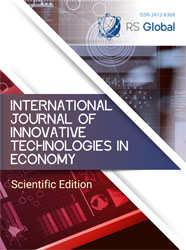METHODOLOGY FOR DEVELOPING MECHANISMS AND TOOLS IN THE MARKETING MANAGEMENT SYSTEM
Abstract
In practice, a systematic approach is needed that allows you to combine the assessment and further changes in marketing activities. Such an approach should take into account the adoption of managerial decisions regarding improving the efficiency of marketing based on a system of assessment indicators, both marketing activities and the business as a whole, and provide for a program of coordinated changes in business and marketing, which allows to improve these indicators. taking into account the characteristics of the external environment and the resource potential of the enterprise. The result of using this approach is a more efficient state of marketing and business systems, ensuring their interconnection and coordination, taking into account market conditions. The development and implementation of a systematic approach contributes to the application of the theory and methodology of change management in the context of increasing the effectiveness of marketing activities.
References
Antones V.Q. Marketing strategy for the development of industrial tourism. Autocan. Donetsk: LSU. 2017, -30 p.
Agaeva A.N., Vasilchenko T.Z. Comparative characteristics of marketing research methods // Bulletin of BUPK, No. 1, 2011.
Artomova E.N., Kozlova V.A. The basics of hospitality and tourism. Eagle: GTU. 2005, - 104 p.
Almosov S.M. Hotel business. M., Laboratory book. 2011.- 94 p.
Abdulov A.V. The use of information technology in the hotel industry. // Collection. Omsk: OMIS. 2015, p.45-46.
Bezrutcenko Y.V. Marketing in social and cultural services and tourism. M .: Dashkov and K. 2016, - 232 p.
Ramiz Balashirin Alekperov, Ibrahimova Kyonul Akbar, Neural Network Modeling and Estimation of the Effectiveness of the Financing Policy Impact on the Socio-Economic Development of the Socio-Educational System, Conference: 13th International Conference on Theory and Application of Fuzzy Systems and Soft Computing — ICAFS-2018, DOI: 10.1007/978-3-030-04164-9_99
Karsev A.P., O.A. Shevchenko. Marketing research and situational analysis. Lıbersi: Yurait. 2016, - 323 p.
Kireenko N.V., Marketing in the management system of small and medium enterprises. Minsk: Misasta.2015,-211 p.
Kitova O.V. Marketing performance management: methodology and design modeling. M .: INFRA-M. 2012,-328 p.
Korotkov A.V. Marketing research. M .: Yurayt. 2016, - 595 p.
Kozina E.V. The practical program of revolutionary transformations “20 keys” - A modern approach to the modernization of enterprises // Science of Science. 8, №2, 2016, p. 1-14.
Kuzmina E.E. , G.R Suzdalyova. Marketing. Liberians: Yurayt.,2018, - 383 p.
Lamben J.J. Market oriented management. Per. from English SPb .: Peter. 2007, - 800 p.
Lipsis I.V., Oiner O.K. Marketing management. M .: Yurayt.,2016, - 376 p.
Rahib Imamguluyev, Application of Fuzzy Logic Model for Correct Lighting in Computer Aided Interior Design Areas, In book: Intelligent and Fuzzy Techniques: Smart and Innovative Solutions, 2020, DOI: 10.1007/978-3-030-51156-2_192
Vanhaverbeke, W., Chesbrough, H., & West, J. (2014). Surfing the new wave of open innovation research., New Frontiers in Open Innovation, 281–294. Oxford: Oxford University Press.
Watkins, K.E., & Marsick, V.J. (1993). Sculpting the learning organization: Lessons in the art and science of systemic change. San Francisco: Jossey-Bass. (1996). In action: Creating the learning organization. Alexandria, VA: American Society forTraining and Development.
Yang, B., Watkins, K.E., & Marsick, V.J. (2004). The construct of the learning organization: Dimensions, measurement, and validation. Human Resource Development Quarterly, 15(1), 31–55.
Yun, J.J. (2015). How do we conquer the growth limits of capitalism? Schumpeterian dynamics of open innovation. Journal of Open Innovation: Technology, Market, and Complexity, 1(1), 1–20.
Views:
537
Downloads:
462
Copyright (c) 2020 Cinara Kocarieva

This work is licensed under a Creative Commons Attribution 4.0 International License.
All articles are published in open-access and licensed under a Creative Commons Attribution 4.0 International License (CC BY 4.0). Hence, authors retain copyright to the content of the articles.
CC BY 4.0 License allows content to be copied, adapted, displayed, distributed, re-published or otherwise re-used for any purpose including for adaptation and commercial use provided the content is attributed.











